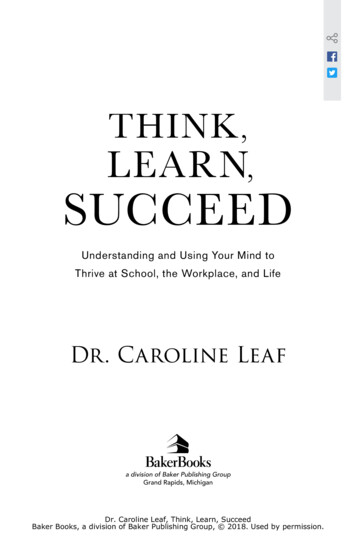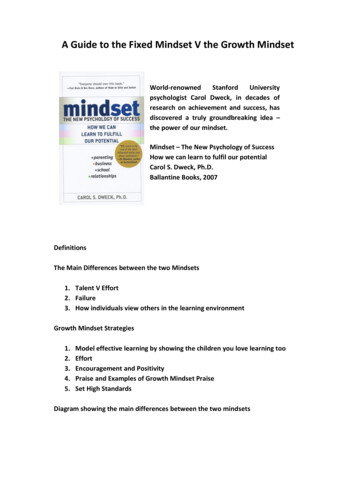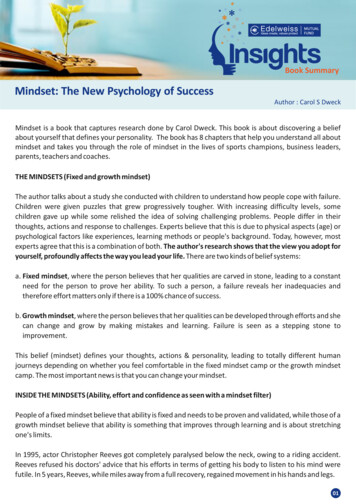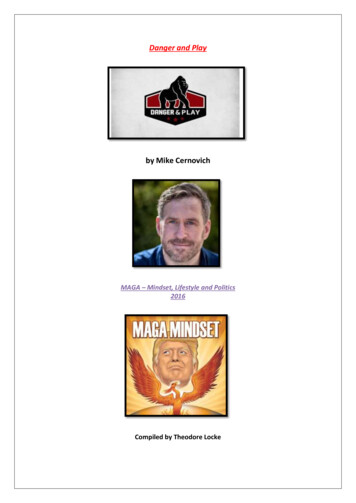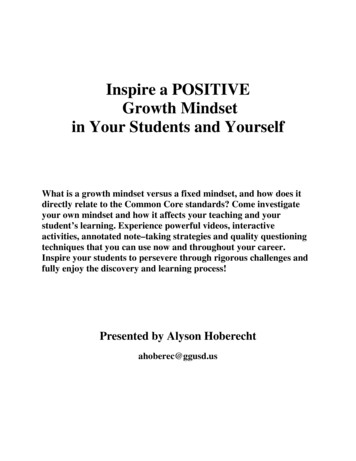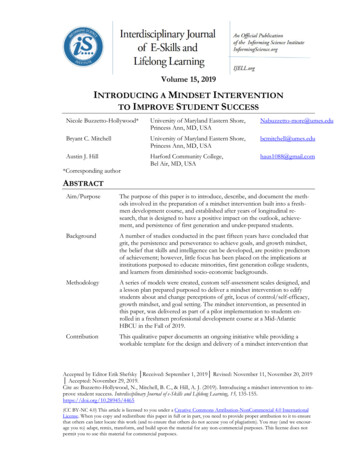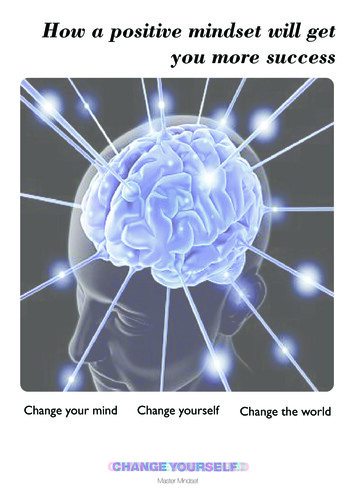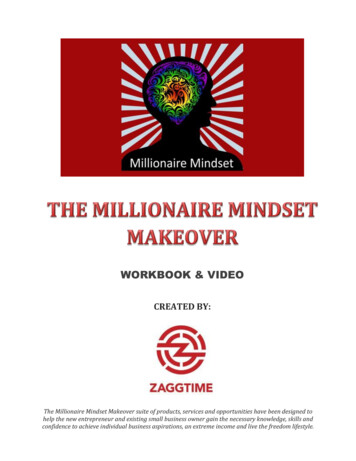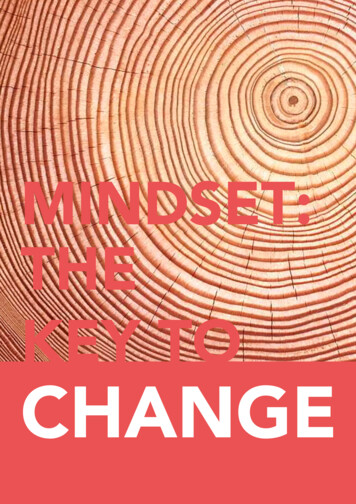
Transcription
MINDSET:THEKEY TOCHANGE
MINDSET IS THE KEY TO CHANGEAuthor: Ina Todorova - ina.p.todorova@gmail.comCoordinator: Lena Nasiakou – lenasiakou@gmail.comGraphic Design: Elena Zanchetta - elena.zanchetta15@gmail.comPhotos: Ina TodorovaNeither the Olde Vechte Foundation, The Dutch National Agency, European Commission nor any person acting on behalf of them can beheld responsible for the use that might be made of the following information. Reuse is authorised provided the source is acknowledged. Thereuse policy of European Commission documents is regulated by Decision 2011/833/EU (OJ L 330, 14.12.2011, p. 39). For any use orreproduction of music, photos, illustrations or other material that is not under the EU copyright, permission must be sought directly from thecopyright holders. A licence is associated with each resource, so everyone can use share and adapt it under specific conditions. An openlicence is not a transfer of copyrights or Intellectual Property Rights (IPR) and the benefit. Open licenses with specific conditions, inparticular: That the creator has to be indicated whenever the work or a derivative is used or shared; That the work cannot be usedcommercially (e.g. sold by others, integrated into a commercial text, book, etc.); That any derivatives have to be shared under the samelicense or licensing terms.The Regulation (EU, Euratom) No 966/2012 of the European Parliament and of the Council of 25 October 2012on the financial rules applicable to the general budget of the Union and repealing Council Regulation (EC, Euratom) No 1605/2002 (OJ L298, 26.10.2012, p. 1) as it was amended by Regulation (EU, Euratom) 2015/1929 of the European Parliament and of the Council of 28October 2015 amending Regulation (EU, Euratom) No 966/2012 on the financial rules applicable to the general budget of the Union (OJ L286, 30.10.2015, p. 1), and The Commission Delegated Regulation (EU) No 1268/2012 of 29 October 2012 on the rules of application ofRegulation (EU, Euratom) No 966/2012 of the European Parliament and of the Council on the financial rules applicable to the generalbudget of the Union (OJ L 362, 31.12.2012, p. 1) as it was amended by Commission Delegated Regulation (EU) 2015/2462 of 30 October2015 amending Delegated Regulation (EU) No 1268/2012 on the rules of application of Regulation (EU, Euratom) No 966/2012 of theEuropean Parliament and of the Council on the financial rules applicable to the general budget of the Union (OJ L 342, 29.12.2015, p. 7)MINDSET IS THE KEY TO CHANGE – BULGARIA 2
CONTABSTRACT4INTRODUCTION5THEORY BIT7FIXED – GROWTH MINDSET8OUTWARD MINDSET9FOUR COMMUNICATION STYLES13GAMIFICATION19IMPROVISATIONAL THEATRE19PRACTICE BIT 20FOUR COMMUNICATION STYLES21GAMIFICATION22IMPROVISATIONAL THEATRE23CONCLUSION24BIBLIOGRAPHY25MINDSET IS THE KEY TO CHANGE – BULGARIA 3
ABSTRACTSynergy Bulgaria organised a Study Visit as an activity for the ReACT project inJune, 2019. The aim was to share knowledge, experience and methodology that weuse in our daily work, to present the best case practices and last but not least - tostrengthen the connection between the organisations. To achieve all that we built aprogram that included tools from coaching, personal development, gamification,impro theatre and body movement. Participants had the chance to experience newactivities and to bring all of it back home to use in their everyday work.MINDSET IS THE KEY TO CHANGE – BULGARIA 4
INTRODUCTIONThe aim of this chapter is to present the main tools and methods used during theStudy Visit. They are all focused on the target group of the project – people workingwith long term unemployed adults.Working with long term unemployed adults many times sums up to teaching newskills or providing qualifications. There are many institutions that are there to supportpeople in having free courses and trainings. The end result mostly is some new skillson a basic level. What we believe though is that skills-trainings are ineffective withoutworking on people’s mindset. That is exactly the reason why the whole Visit wentunder the question “What is the change that needs to happen?”MINDSET IS THE KEY TO CHANGE – BULGARIA 5
Using an open discussion at the very beginning of day one we set up a commonground stating that skills-trainings are ineffective without working on the mindset ofpeople. We look at it as the way people think about an ability and/or talent. Beingwithout a job for a long term (which is considered to be more than 27 weeks) canmake it difficult to overcome the impact this has on the individual’s self-esteem,confidence, motivation, well-being and might cause doubt in personal qualifications.When it comes to this attitude towards the self - level and amount of skills makes nodifference anymore.Ultimately the mindset influenceseverything, from creative risk-taking tohow you view feedback to whether ornot you finalize difficult tasks. It isactually one of the greatest factors indetermining whether or not one growsand improves their abilities.Having the right mindset is the key to overcoming eventual damage from theunemployment but working on that is not an automatic process.MINDSET IS THE KEY TO CHANGE – BULGARIA 6
THEORY BITMINDSET4 COMMUNICATION STYLESGAMIFICATIONIMPROV THEATREMINDSET IS THE KEY TO CHANGE – BULGARIA 7
FIXED – GROWTH MINDSETDuring the activity we focused on the types of mindset - Fixed and Growth. The Fixedmindset suggests that the abilities are innate and unchangeable whereas the GrowthMindset views it as something you can improve through practice. In the fixed mindsetfailure is being viewed as permanent but with a growth mindset it is seen as a chanceto learn.People with a fixed mindset are more likely to view negative feedback as a personalattack while the others will see it as a chance to improve and develop a new system.With a fixed mindset you are more likely to go for easier tasks and invest minimaleffort. After all - if talent is a fixed thing why bother working on it and improving? Notonly but if one does not have it then a fixed mindset will never allow him/her to workfor it. On the other side, with the growth mindset one is more likely to embrace thechallenge and work hard on improving.Fig.1 - source: 035584MINDSET IS THE KEY TO CHANGE – BULGARIA 8
The ones with a fixed mindset are more likely to give up when an obstacle appears.Meanwhile people with a growth mindset will see the same obstacle as a chance toexperiment.When it comes to results in the fixed mindset the focus is on measurableaccomplishments but with the growth one the focus is more on a journey of continualimprovement.When it comes to working with people our main focus has always been on buildinga connection. Here in use comes the concept of the outward mindset.OUTWARD MINDSETThe very first step is to see other people as people. As strange as this might sound,and especially in the context of working with long-term unemployed people, it is achangemaker to be interested in the person or the group of people not just becauseit is part of the job but to make them, their needs and goals important. Once gettingto this Outward mindset people tend to go about our lives and work activities in waysthat are more naturally helpful to other people. In an opposite experience we are noteven curious about the needs and the objectives of others. In these moments otherpeople aren't really people to us. They are more like objects. When we dont seeothers' needs and objectives, everything we do tends to be about us, self focused.Even though we might be well intentioned but we just don't see our impact on otherswhen we are inward because we are not taking others into account. The differencein our experience with our people moment by moment depends on our mindset.When looking outward and seeing other people we have what is called an outwardmindset. Having in mind the target group of this project - people who work with longterm unemployed adults, we believe that having an outward mindset is the key tosuccessfully supporting people. Having the outward mindset is a good approachtowards working with long-term unemployed people. What comes next is a few stepsthat we believe can add to the mindset and the intention to help and support thosepeople.MINDSET IS THE KEY TO CHANGE – BULGARIA 9
HOW TO IMPLEMENT THIS?The very first step is to get out of the box. This one is a process on its own and thefirst thing to get you there is to notice the indications of the box. What we mean bythat is to be able to disregard all your judgements towards the person in front of you(such as that he/she is not good/qualified/young/old enough) and see things as theyare and do things that you believe are right. Of course this does not mean to get ridof your judgements because that is not possible. What it means is to be aware thatthose judgements are simply your thoughts, something you made up in your head. Agood example is for parents - in the desire to give all the best possible we never getinto the box when thinking or doing something for our kids. Think of someone whoimmediately gets your thinking and behaviour out of the box. In this way you willexperience the feeling that this brings.\Learning about the other person's current situation, past experience, needs anddesires for the future is what is needed for one to guide this person into achievingwhat he wants and finding a new job (in our scenario). Instead of acting fromobligation when it's simply following steps of a procedure, for building a realconnection with the person (a.k.a step two) we need to take into account the specificsof what we are working with. Following the flow of the graph above, listening andlearning is the next step and all it takes is to be fully open for the person.\Very often we hear what people say but we don't listen to it. It’s very easy to slip intothe box and start putting labels on what comes from the other side such as somethingthey are doing is stupid, what they want is not possible, the experience they have isnot enough for the job that they want and that it’s not going to work. If you are reallylistening to the person you work with you will start learning about the life of the personand what is really important for him/her.MINDSET IS THE KEY TO CHANGE – BULGARIA 10
Figure 1 is a scheme we made as a result of the Study Visit. It visualises our method.After you already are familiar with the needs of the other person you can proceedwith teaching. Key point here is communication. What we mean by teaching is to givevalue - new skills, something he/she wants to learn and that is relevant for this personin the current situation. You don’t judge on what is being done wrong but supportingthings to go right (example: “You are doing this wrong.” vs. “Let me show you how todo this more efficiently/faster/in an easier way.”).MINDSET IS THE KEY TO CHANGE – BULGARIA 11
Teaching something relevant means not something that is relevant for you or whatyou think is needed but something that is valuable and needed from the person youwork with. This is why listening and learning is very important.As you might already see it’s a parallelprocess - every step is a continuation ofthe previous ones.Only after you’ve already been through the steps above you reach a point where youcan go for correcting if needed. You can share with the person that something he/sheis doing is maybe not the best thing to be done, maybe it leads to a not-desired resultand to show this person how he/she can correct it. It's the very last step and it worksonly if everything else before that is taken care of.In case you get a negative reaction when you go for correction and the person getsannoyed, angry, he/she disconnects - it means there is a problem in the previous step.When you are not able to teach and the person does not accept the value you wantto give and doesn't want to communicate with you - then there is a problem in theprevious step. It means you didn't listen and learn, you didn't get how to get to theperson and what verbal and body language would influence him/her. Going back tolistening and learning might be that the person does not want to share theinformation that is needed with you. This means that the steps towards building theconnection are not made.MINDSET IS THE KEY TO CHANGE – BULGARIA 12
In a situation where all this does not work there is a question you could ask yourself\ What is your judgement?\ What is the box you put yourself into?\ Which is the box that stops you from seeing the real person in front of you?\ Which one stops you from being real with this person?While being in the box mostly we are in a role, playing a game. We put labels onpeople because it supports an image of ourselves that we have created and want tokeep no matter what.For this method to work at least 80 percent of focus must be spent on helping thingsgo to the right direction (communicating, connecting, caring, listening, learning,teaching, giving a good example). Only maximum 20 percent of the energy andattention should be given to correcting. People are willing to change only if they reallywant to and have a good reason for it - living in a better environment, having a bettercareer, etc.How to present the theory with practice?In order to practically work on the topic of mindset, getting out of the box,communication etc. during the Study Visit we organized multiple workshopsincluding communication skills, gamification and improv theater.FOUR COMMUNICATION STYLESOne of the first topic presented were the four communication styles. First thing toclarify is that these are ways people express themselves. They are not personalitytypes but styles of communication/expression (both verbally and nonverbally). Alsoit is highly likely that someone’s style is an intersection between one or more definedcommunication styles.MINDSET IS THE KEY TO CHANGE – BULGARIA 13
MINDSET IS THE KEY TO CHANGE – BULGARIA 14
Starting with the matrix we show that there are dominant, passive, formal andinformal styles.CONTROLLERPeople with the controller style (dominant, formal) are mostly active, independentand ambitious. They radiate confidence, take initiative and love to organize things.Usually they naturally take the lead. The ease and quick manner in the way theyusually take decisions makes them look efficient, but also might create a feeling inother people of not being able to keep up with them. As a consequence of a strongtask orientation it can be difficult for them to show their emotional side. Because theyprefer order and organization they are able to easily create order in chaos. They liketo have the lead and they do become resistant when others are leading them.In their professional life they like a challenge with speed and getting bored if the paceis too slow. Their need for personal success can limit their ability to work togetherwith others. They usually set goals and work to achieve them step by step. Othersaccept their authority and leadership easily because they guide and help to transformeverybody’s effort into concrete results.Keyword for this style is result. Their movements are sharp, using direct eye contactand strong tonality. Language is sharp, to the point, no small talk. The effective wayto communicate to people with the controller style is to bring up results, summarizefacts, and be specific. Avoid starting a conflict, telling them what to do and being lateor wasting their time.ANALYZERAnother formal style is the analyzer but this time it’s a passive one. People with thisstyle are inclined to focus on gathering data. They aim more at ideas and conceptsMINDSET IS THE KEY TO CHANGE – BULGARIA 15
than relationships and feelings. Above immediate action they prefer to study andconsider very carefully. They often wait until others address them instead of comingin front with their own opinion. Usually they need a lot of facts and opinions beforemaking a decision. Very often a sense of incompleteness might be sensed, becausethey are busy with collecting information even after they have come to a decision.People communicating in this style are inclined to be formal even in personalrelationships and because of that they are often considered as distant.In their work they usually take the task in an ordered and systematic manner. Aimedat details and thorough as they are, they like it when business is rational and wellorganized. When being confronted with a disorganized environment they can betense and even get paralyzed.Keyword for this style is information. Body expressions are restricted, at a slow paceand the voice is monotonic. Language goes from general to specific, everything inchronological order. Communication with them should also go that way. Don’t begeneral or imply that they do not understand.SUPPORTERThe second passive style is the supporter and it is an informal one. Others often seepeople who are communicating with this style as easy and nice. They are morefocused with feelings and relationships rather than logic or tasks. It’s very rare to getin a fight with a supporter. Although they react well to people, in social situations theyleave the initiative with others. They find it hard to refuse a request, because theywant to be helpful, even if it goes against their own interest. Usually they don’t havethe need to impress others or to go into competitions or even to convince someonethat they are right. They appear to have little interest in planning and setting goalsand usually need structure and a specific description of what has to be done. Theywill do everything in order to succeed when doing an assignment, because they wantto serve others.MINDSET IS THE KEY TO CHANGE – BULGARIA 16
In a working context they are aimed at working together and to serve others or thecompany. They work according to the rules in order to avoid that there will bemisunderstandings between people and that is why they accept leadership easily.Supporters are loyal employees when there is an emotional connection. If they thinkthat their idea will benefit others, then they will bring out that idea in a nonthreatening manner.Keyword for the style is cooperation. Movements are relaxed, moderated and thevoice is soft. Language is high on emotions and compliments. For communicationwith them it is important to use a soft voice, to provide details and specific goals, nopressure over time limits. Avoid being harsh or criticising them in public.PROMOTERThe promoter style is dominant and informal. In general people with this style loveinspiring and exciting activities. Because detailed analysing doesn’t go that well withthem they easily generalize on grounds of having too little information. Incommunication they tend to exaggerate. Somewhat prone to drama they can be loudabout certain things in a way to convince others. Their enthusiasm can come acrossas unbalanced or egocentric. They don’t hide their feelings and like to help ininterpersonal situations. People with this style usually don’t care about details and gowithout even completing their task to the next one. They draw conclusionsimpulsively.In their job they want to be liked by others. They attach themselves to leaders (whothey admire and want recognition from). Approval and support motivates them themost. Usually they are loved persons to work with. Their imagination and enthusiasmcan be a great source of motivation. Because they don’t want to stand still at a task,they take pleasure with less quality just to keep going. Promoters work best in anenvironment which offers them some structure through planning and process, whicharen’t natural points of attention.MINDSET IS THE KEY TO CHANGE – BULGARIA 17
Keyword for the promoter style is unique. Body language is expressive with lots ofmovements. Language is loud, at a fast pace, with high tonality. Using humor andenthusiasm is always good to do when communicating with people from that style.Additional thing is giving them public acknowledgement. Spare the negativefeedback (especially in public).The description of the communication styles is only briefly presented since verydetailed information can easily be found online.MINDSET IS THE KEY TO CHANGE – BULGARIA 18
GAMIFICATIONGamification is the application of game elements into non-game problems such asbusiness and social impact environments. The goal of gamification is to engage withothers and the environment, to inspire collaboration and interaction. It takeselements from game-design and the general principles and theories which drivegameplay and applies them to a certain context.Gamification is ordinarily (as we did as well) to solve problems and to motivate peopleto achieve their goals. Knowing the user and identifying the mission are key to gettinggamification right. Because gamification is a very engaging learning strategy, wechoose a specialist to present the concept and work around it on the topic of theReACT project.After explaining some theory on the topic, our facilitator created a space for manydifferent playgrounds to be created.IMPROVISATIONAL THEATREImprovisational theatre (improvisation or improv) is a form of live theatre in which theplot, characters, dialogues, scene or story are made up in the moment. Ideas mightbe taken from the audience or from another source of inspiration (just like in our casewe already had the topic of the project). It can be spontaneous, entertaining, easyand fun but it is a powerful tool to fully experience and see a situation on both theinside and outside of it. There is a practice called applied improvisation which is usedin classrooms as an educational tool and in business as a way to developcommunication skills, creative problem solving and supportive team-work abilities.MINDSET IS THE KEY TO CHANGE – BULGARIA 19
PRACTICE BIT4 COMMUNICATION STYLESGAMIFICATIONIMPROV THEATREMINDSET IS THE KEY TO CHANGE – BULGARIA 20
FOUR COMMUNICATION STYLESWith this group activity on the 4 communication styles you can easily demonstratehow different people communicate with different styles.1.Position the matrix with the communication styles in the room: divide thespace in four, name which wall/side represents which style and put (imaginary) lineson the floor.2.Ask people to position themselves in the room in a way which represents theircommunication style. Do not forget to mention that positioning on the intersection ofstyles is possible.3.Ask a few people (or everyone – depending on the size of the group and thetime available): Why did you position yourself at that place? Use questions to getmore detailed information on how one recognizes his/her style.4.Choose 4 people (one representative of each communication style) to tell astory in front of the whole group for 3-5 minutes (you can suggest topics as „My lastholiday“, „My favourite movie” or let the participant choose the topic).5.After every story, open a discussion about which communication style did theperson use, how did people recognize it and what were the strongest hints.MINDSET IS THE KEY TO CHANGE – BULGARIA 21
GAMIFICATIONFor this activity many materials were provided. The list can go on and not be limitedto: plastic bottles, colourful straws and balls, balloons, strings and ropes, blindfolds,colourful papers and cardboard, markers etc. Participants are being divided intoteams and have the assignment to create a game where one person (or more) is inthe position of the learner (representing the long-term unemployed in the context ofthe project) and another person is in the position of the coach/mentor/etc. The firstneeds to be guided through an obstacle. Each group has to come up with a game,rules and using the materials they create a “playground“. After the time forpreparation is up each group has a turn to present their game. First thing a groupdoes is to explain the rules to everyone. After that a demo is being held which leadsto debriefing questions. As a facilitator you ask questions such as What worked well?,What did not work?, What was the strategy? (if there was any). How did you feel?(asking both of the people), What could work better?. Depending on the group sizeyou can set a limited time for the debriefing and as well provide the opportunity for asecond try of the game. Debriefing after a second go might compare the differencebetween the tries and what was different at the approach and result.MINDSET IS THE KEY TO CHANGE – BULGARIA 22
IMPROVISATIONAL THEATREAll the people are divided into working groups. The size of the groups depends onthe amount of people but equal distribution is preferred. Then each group is given 20minutes to decide on a problem that they want to present through their performanceand how they are going to do it. The goal is that after the problem is presented thewhole group creates a discussion on what is everyone’s experience with it and whatmight be a solution for it. The facilitator walks around and supports the workinggroups in case there are questions. After the first 5 minutes are over and the problemis clear for each group (in case it’s not you can give additional time) its show time.One by one groups are performing their improvisations. After each performance thefacilitator asks the rest of the participants to identify the problem that was justpresented and how familiar they are with it – have they ever experienced somethinglike it. Last thing to discuss before going to the next performance is what might be asolution and sharing personal experiences on dealing with something similar.MINDSET IS THE KEY TO CHANGE – BULGARIA 23
CONCLUSIONTogether with the 12 participants of this Study Visit we started from a point wherewe all concluded what is an important starting point when working with long-termunemployed people - their mindset. FIrst it was crucial to introduce the differenttypes of mindset we focused on and how we can influence others to switch from anon-supportive one to another that can bring up many new opportunities. Thesecond focus of this training was based on practice. The participants took part ofdifferent workshops and learnt new techniques on how to create their uniqueapproach towards the people they work with, starting with recognizingtheir communication style.At the end of the Study Visit the representatives of all the partners organizations ofthis project went back to their teams with new knowledge and perspective onworking with our common target group - people who work with long-termunemployed adults.MINDSET IS THE KEY TO CHANGE – BULGARIA 24
BIBLIOGRAPHYArbinger Institute, (2015), The anatomy of peace: Resolving the heart of conflict, SanFrancisco, CA : Berrett-Koehler Publishers, 2006Chalmers Brothers, (2004), Language and the Pursuit of Happiness, NewPossibilities Press, 2004MINDSET IS THE KEY TO CHANGE – BULGARIA 25
When looking outward and seeing other people we have what is called an outward mindset. Having in mind the target group of this project - people who work with long-term unemployed adults, we believe that having an outward mindset is the key to successfully supporting people. Having the outward min
